This section introduces some of the common fish species seen in Redang and other tropical reefs. They are listed by their common and family names. Only a few representative species of each family are shown to illustrate some of the visible characteristics like body, fin and tail shapes. When we encounter an unknown fish, recognizing these may help identify the family that particular fish belongs to, which allows us to narrow our search when we look up reference books. For more information, check out websites like What's That Fish or a good fish reference book such as 'Reef Fishes of the World' by Lieske and Myers, Periplus ISBN962-593-960-1.
Many reef fishes change their sex under certain conditions to ensure continued survival and reproduction of their species. Most are sequential hermaphrodites, changing sex one way. Certain anthias and wrasses exhibit protogyny, where females become males, while anemonefish exhibit protandry, where males become females. Many gobies can alternate between being male or female. A few are simultaneous hermaphrodites, like seabass and hamlets, which are male and female at the same time.
Many reef fishes also change their patterns and colours over their lifespan as they grow from juveniles into adults. Some mimic a different species when young, others
 Protect our marine life
Protect our marine life
Do not chase, harass or catch fish and other marine life even if you intend to release them later. Handling may stress and injure them, expose them to predators or cause them to behave defensively.
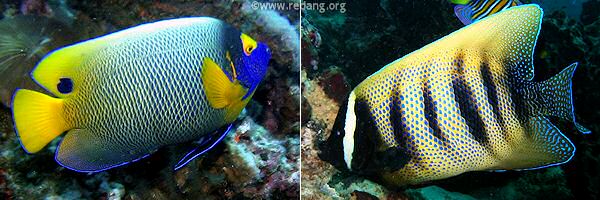
Bluefaced angel (left) and Regal six-bar angel fish.
Angelfish (Pomacanthidae) are close relatives of butterflyfish but are usually larger, growing up to 60cm long. Both have flat disc-shaped bodies but only angelfish have a protruding spine on the lower edge of the gill cover which is used for defense. Angelfish are usually timid but territorial, and shelter near boulders, caves and coral crevices. They feed primarily on invertebrates, algaes and sponges. Their body colours change as they mature from juveniles to adulthood. Many angelfish species are also observed in pairs.
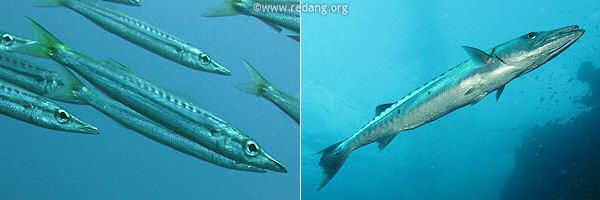
Yellowtail barracuda (left) and great barracuda.
Barracudas (Sphyraenidae) often congregate in schools in the day except for the great barracuda which is solitary (seen alone). They have two widely separated dorsal fins on a long, silvery body with prominent sharp teeth which gives them a somewhat menacing appearance. They are fast, voracious predators, feeding on other fishes. The great barracuda can grow up to 1.8m in length and is often curious but not dangerous unless provoked. While there have been a few cases of larger barracudas attacking swimmers or snorkellers, these may be due to mistaken identity as barracudas are known to be attracted to shiny objects like rings, metallic watch straps, jewellery or bracelets, mistaking them for silvery fishes.
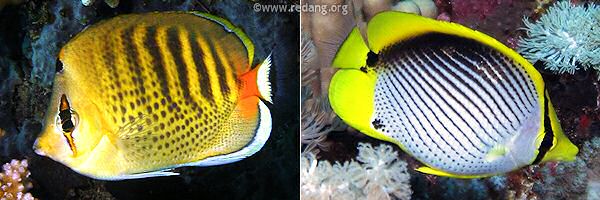
Spot banded butterflyfish (left) and Black-backed butterflyfish.
Butterflyfish (Chaetodontidae) comprise almost 130 different species, including bannerfishes. They are usually seen in pairs and bond faithfully for life, though some species may also be seen in large schools feeding on plankton. They feed mainly on live corals, small invertebrates, fish eggs and algae. Many have bright yellowish markings and often have false eye spots. Most are small, below 30cm in length. Some species have elongated snouts. Most species are non-territorial and non-aggressive, making them popular aquarium fishes. Bannerfishes have long flowing dorsal fins and are often mistaken for Moorish Idols which are not butterflyfishes but more closely related to surgeonfishes.
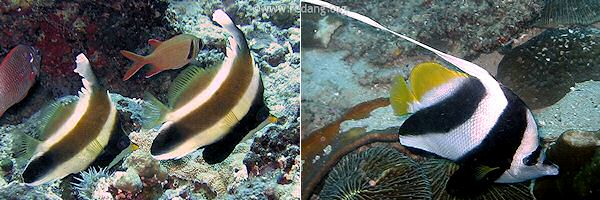
Pennant bannerfish (left) and Long fin bannerfish.
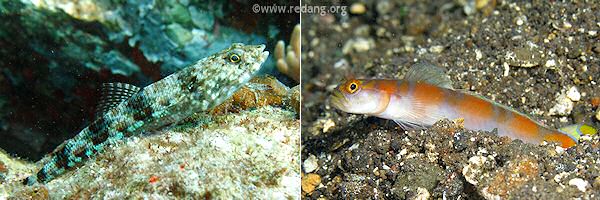
Lizardfish (left) and Prawn goby.
Blennies (Blenniidae) and gobies (Gobiidae) are small fishes usually seen perched on a coral, rock, seabed or at the entrance of holes and crevices. Blennies have one long continuous dorsal fin and blunt faces that resemble a frog or grasshopper with mouths under their faces. Some species have characteristic 'eyelashes' or whiskers (called cirri). They move around by hopping from rock to rock and scurrying about on their pectoral fins. They are mostly herbivorous and lead a solitary lifestyle.
Gobies are the smallest fish on the reef, rarely exceeding 10cm in length, but are the largest family of fish with more than 1600 species. They have two distinct dorsal fins. Gobies have fused pelvic fins like a suction cup upon which they perch and strong pectoral fins which they use as arms to move around. Gobies sometimes share their burrows with shrimp - while the goby stands guard at the entrance, the shrimp does the housework. They have a wide range of diets, from tiny crustaceans, worms, sponges, eggs of other fish to scavenging parasites from larger fish. The common mudskipper is a specialized goby that has the ability to live out of water for extended periods.
Lizardfish are much larger (growing up to 27 inches) with elongated cylindrical bodies and also like to perch motionless on corals, rocks or seabed waiting to ambush their prey. Their faces resemble those of reptiles like lizards and their sharp teeth are usually visible. They are carnivorous and feed on small fishes.
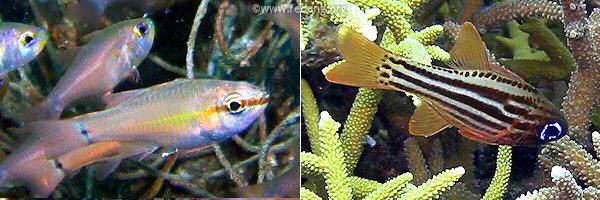
Orange-lined cardinal (left) and Ochre-striped cardinal fish.
Cardinalfishes are small elongated fishes with two dorsal fins and a long tail base. They are usually found in schools hiding amongst branching coral in the day and come out at at night to feed on zooplankton and tiny invertebrates. Some species have bacteria in their organs that are bioluminescent, making them glow in the dark. With about 250 species worldwide, they are the damsels of the night and are often encountered on night dives wandering about in the open. The males protect and incubate the eggs in their mouth, going without food until the eggs hatch.
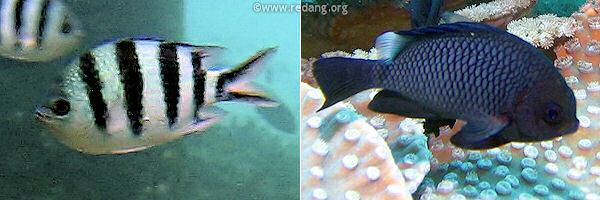
Scissor-tail sergeant (left) and black damsel.
These small fishes are the most prolific species on the reef and are among the first fishes one notices in Redang (especially during fish feeding). With over 320 species worldwide, the family of damsels include the colourful anemonefishes (like Nemo), sergeants, lemon damsels, blue chromis and dascyllus. Damsels have one continuous dorsal fin with moderately large scales. Most, like the black damsels, are highly territorial and will zealously guard their algae-rich turf where they feed and nest, even nipping at snorkellers and divers who come too close. Eggs are looked after by the male until they hatch. Damsels feed on algae, plankton and invertebrates. Anemone fishes are damselfish which have developed an immunity to the anemone's stinging tentacles and are often found taking refuge within the waving arms of anemone coral.
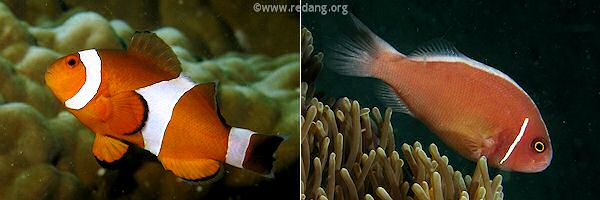
False clown anemonefish (left) and pink anemonefish.
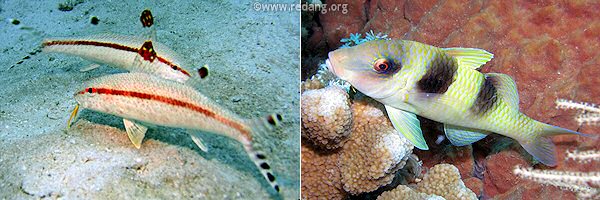
Bar-tailed goatfish (left) and two-barred goatfish.
Goatfish are easily identified by a pair of barbels (whisker like appendages) on their chin and their forked tail fins. The barbels are sensitive and used to detect their prey hiding beneath the sand. They forage about on the seabed individually or in schools, poking their barbels into the sand. They feed on worms, small crustaceans and molluscs. They are also eaten as food fishes.
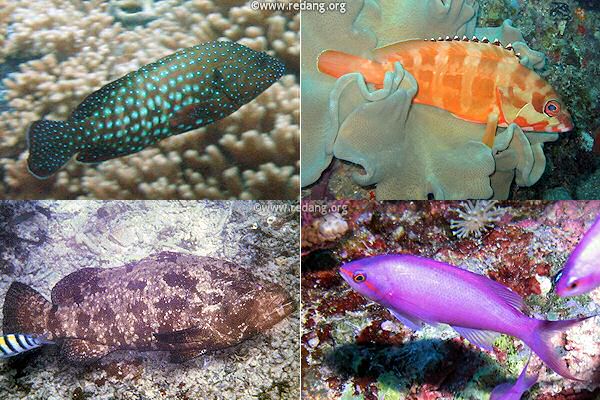
Clockwise from top-left: Longfin grouper, barred rockcod, purple anthias and giant grouper.
The large Serranidae family of fish include groupers, rockcods, coral trout, sea basses and basslets. Groupers & rockcods have prominent jaws with canine teeth, mottled patterns and camouflage colours. Groupers are the largest in this family, and it is often an exciting experience to encounter the giant groupers in Redang, which can grow up to 170 cm. Rockcods are small to medium sized. You can find a resident giant grouper under the jetty at the Marine Park Centre, another at the shipwreck, and 1 or 2 at the reef around Redang Reef Resort. Groupers and rockcods are the top reef predators and are carnivorous feeding mainly on fish and crustaceans. These predators also often fall prey to man and appear on many a seafood restaurant's menu.
Basslets (Anthias) are small fishes typically seen in large congregations. You can't miss them - they are brightly coloured and are normally found hovering near hard coral. They have fairy-like anal and pelvic fins, a tail fin that is usually forked, and one continuous dorsal fin. Their translucent fins earned them the nickname of 'fairies of the reef'. Growing only up to 15cm length, they are common food-fish for eels, groupers and rockcods.
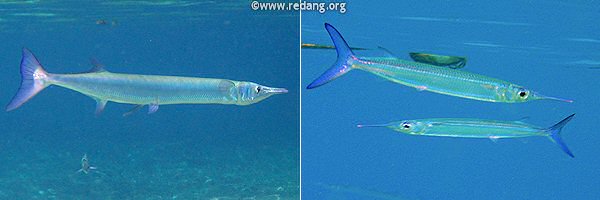
Needlefish (left) and halfbeaks at the Marine Park Centre.
Both are silvery fishes with elongated bodies and long needle like mouths. When pursued by predators, they sometimes leap into the air to escape and in rare cases, these leaping fish may injure people in their path. Needlefish are often seen in schools just below the water surface, hunting small surface fishes. They have a somewhat aggressive appearance due to their numerous tiny teeth being visible within their long extended upper and lower jaws. They range in length from 45-130 cm.
Halfbeaks (also known as garfish) are also frequently seen in schools just below the water surface. They can be distinguished from needlefish by a short upper jaw and a greatly extended lower jaw and their forked tails. They feed on algae, plankton and insects on or near the water's surface. Needlefish and halfbeaks are very common at the Redang Marine Park Centre. The larger needlefishes about 70-90 cm long are commonly seen swimming alone or in small schools while the halfbeaks tend to congregate in larger schools.
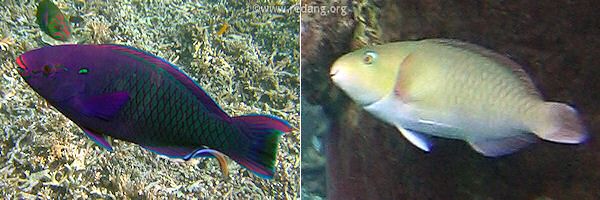
Swarthy parrotfish (left) and long-nosed parrotfish.
Parrotfish are easily identified by their beak-like jaws which are actually fused teeth used for crunching rocks and corals when feeding on algae. They are medium to large fish and the biggest, the bumphead parrotfish, can reach 2m in length. They have varying colour patterns and swim like wrasses do in the same bird-like flapping fashion using their pectoral fins. Humpheads can be spotted sometimes at the Marine Park Centre, to the west of the jetty, and near the shipwreck. These herbivores graze individually or in schools, feeding mainly on algae, scraping them off rock or coral. The huge amounts of coral and rock that is consumed is ground to fine powdery sand which is excreted - this can sometimes be seen as a cloud of white sand trailing the parrotfish. A single parrotfish can generate up to 300 lbs of sand a year.
Some species of parrotfish build a cocoon around themselves to protect them when they sleep, dismantling the cocoon when they awake. Some species are nomadic, moving from reef to reef to feed, while others are resident.
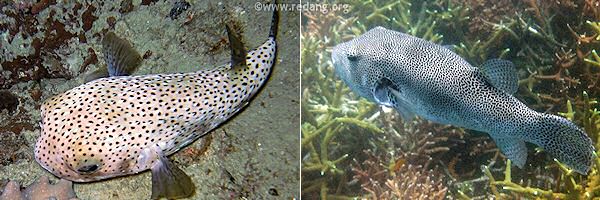
Blackspotted porcupinefish (left) and star pufferfish.
Porcupinefish and pufferfish are close cousins. Both have the ability to inflate themselves to deter potential predators.
Porcupinefish have spines covering their head and bodies which are absent in pufferfish. These spines point outward when inflated, a powerful deterrent to potential predators. Porcupinefish are awkward swimmers with a style that makes them endearing.
The pufferfish has a more potent defense - it can release a powerful toxin through its skin when threatened. This toxin, called Tetrodotoxin, is more powerful than cyanide and is produced in the liver and ovaries. A number of people die each year eating the puffer. They are a delicacy in Japan where they are known as 'fugu', and fugu chefs must be specially trained and licensed in the preparation to effectively remove all the poisonous parts of the fish, which is then served raw as in sushi or cooked. Even then, eat at your own risk! I'd rather just watch the cute fish!
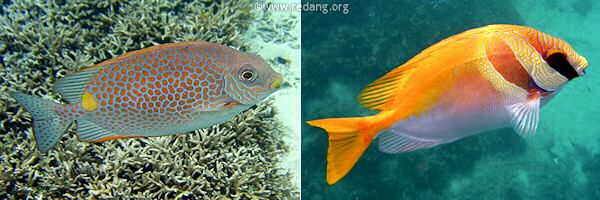
Golden rabbitfish (left) and two-barred rabbitfish.
Rabbitfish have venomous fin spines which can inflict painful wounds but are not dangerous. They feed on algae and usually swim in pairs or schools. They are also caught and eaten as food fishes.
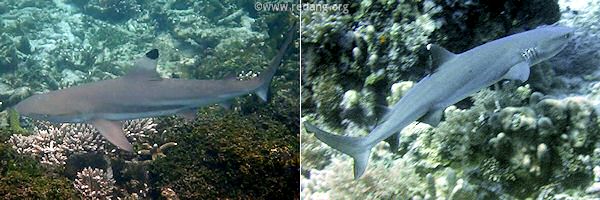
Blacktip reef shark (left) and whitetip reef shark.
Blacktip reef sharks are the most commonly encountered shark species in Redang. They are readily identified by a black tip on its dorsal and lower tail fins. Growing to a maximum length of about 1.8 metres, this shy and timid shark prefers to avoid humans and is not considered dangerous. They love shallow water and there are baby blacktips in Shark Bay and Pulau Lima. Adult blacktips will occasionally swim in and out of the housereefs at Tanjung Tengah, Tanjung Mak Cantik and Teluk Kalong. Their diet consists mainly of small fish, cephalopods and shrimps.
Other sharks in Redang include the whitetip reef shark, leopard shark, nurse shark and bamboo shark. The largest fish in the world, the whale shark occasionally makes an appearance in Redang waters during certain seasons feeding on plankton. None of the shark species found in Redang are considered dangerous. In fact, only 35 species of sharks (out of 400+ species found worldwide) have been involved in attacks on humans and most of these attacks involve the 3 most dangerous shark species which are the bull shark, great white and tiger shark.
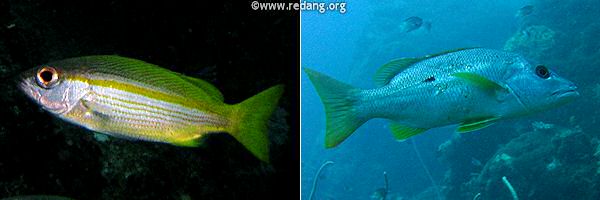
Bigeye snapper (left) and Onespot snapper.
Snappers can be easily identified by their unique body profile and by their triangular pointed faces. Sometimes their canine teeth are easily visible. These shy and timid fish hang around in small to large schools in the day and feed nocturnally on smaller fish, crustaceans and plankton.
They are medium to large fish up to 2m in length. A favourite on the dinner menu, they are sometimes the cause of food poisoning due to ciguatera toxins being stored in their skin.
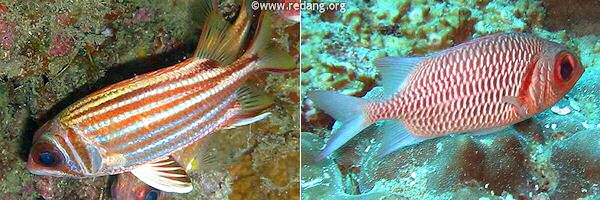
Squirrelfish (left) and soldierfish.
Soldierfish and squirrelfish are predominantly red, have large scales and large eyes. Squirrelfish have a venomous spine on their gills which is absent in soldierfish and can inflict a painful wound. They are mainly nocturnal, as suggested by their large eyes, and can often be seen hiding in groups near corals, caves or beneath ledges during the day. They forage at night, feeding on small fishes, invertebrates or tiny crustaceans.
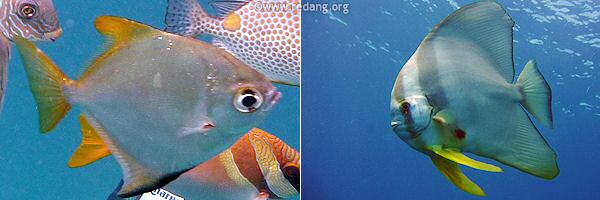
Silver mono (left) and batfish (circular spadefish).
Spadefishes have a flattened appearance, distinct circular shaped body and long dorsal and anal fins which are symmetrical. They feed on algae, tiny invertebrates and small fishes. Juvenile spadefish look very different from adults, having a tiny body with very long dorsal and anal fins. These fins grow shorter as they grow bigger. Spadefishes can be found solitary or swimming in schools. Monos also have long symmetrical dorsal and anal fins and have silvery diamond-shaped bodies.
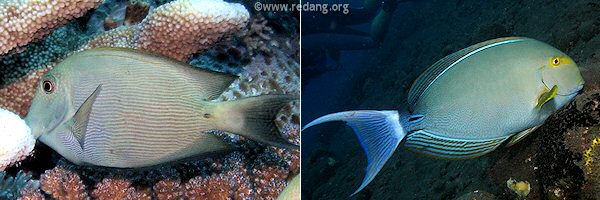
Striped bristletooth surgeonfish (left) and Yellowfin surgeonfish.
Surgeonfish (which includes unicornfishes) have a characteristic retractable sharp scalpel-like spine at the base of their tails which can be venomous in species like the blue striped surgeonfish. They are about 20-100cm in length, have oval-shaped bodies, eyes set high on their heads and small mouths. They are usually seen in small congregations grazing on vegetation and algal mat off corals. Though timid, if threatened, surgeonfish will slash at enemies by erecting their spines and sweeping their tails. Perhaps the best known surgeonfish is 'Dory' in the movie 'Nemo', also known as the palette surgeonfish.
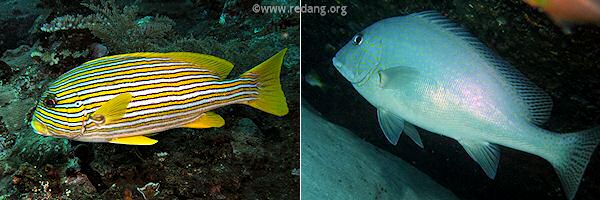
Ribbon sweetlips (left) and Gold-spotted sweetlips.
Sweetlips are medium to large fishes with continuous dorsal fins. Their name is derived from their large, fleshy lips. Their markings and colouration change from juveniles to maturity. Many species have a characteristic twisting, undulating swimming motion. They are often inactive by day, resting or hovering in small groups near sheltered areas or under ledges and feed at night on invertebrates. They are also eaten as food fishes.
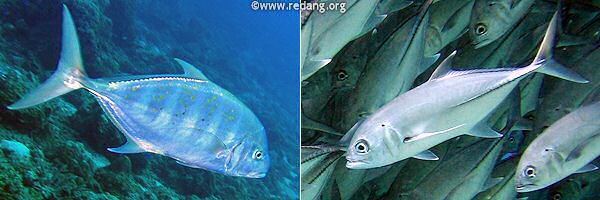
Yellowspotted trevally (left) and jack.
Trevallys and jacks are medium to large fast swimming predatory fishes and can often be seen attacking schools of smaller fishes in coral reef areas as well as in the open sea. Most species have silvery bodies with narrow caudle peduncles (base of tail fin). Trevallys like to swim in small schools while jacks are often found in large schools comprising hundreds of individuals. Many of them are also eaten as food fishes.
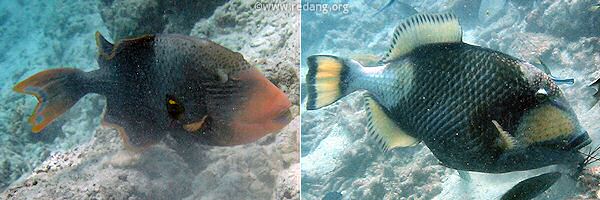
Yellowmargin triggerfish (left) and Titan triggerfish.
The 'triggerfish' derives its name from the characteristic locking and unlocking of their first dorsal fin like cocking a trigger. The dorsal fin lies in a flat groove on the top of the body but can be locked upright to wedge the fish into some crevice in which it has taken refuge, preventing it from being pulled out and eaten. They are solitary and are relatively poor swimmers. Their powerful bite allows them to make meals of shelled invertebrates and sea urchins, and they are also a natural predator of the Crown of Thorns starfish.
Triggerfish can be aggressive during nesting season, when they stay close to their nests and aggressively chase and bite anything that ventures near, including divers and snorkellers. There are many species of triggerfish but the larger ones like Titan triggers (common in Redang) and Yellowmargin triggers are best avoided.
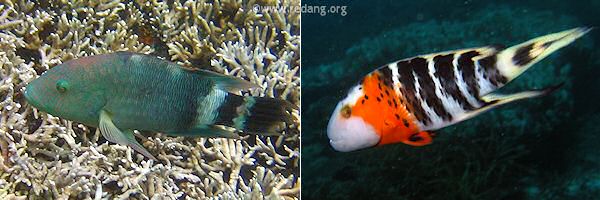
Tripletail wrasse (left) and Red-banded wrasse.
This is another large group of fishes that come in all shapes and sizes. Most juveniles have a drab appearance but become brightly coloured as they mature or when females change their sex. Some species feed on plankton, others are carnivores while some are cleaners, removing parasites from other fishes. Wrasses have a single continuous dorsal fin, and have a characteristic bird-like flapping action of the pectoral fins while swimming. Cleaner wrasses are among the smallest at a few centimetres while the largest, the Napolean (or Humphead wrasse) can reach lengths of over 2 metres. Generally timid and non-territorial, these free swimming fishes can be found almost anywhere on a reef, either alone, in pairs or in groups.